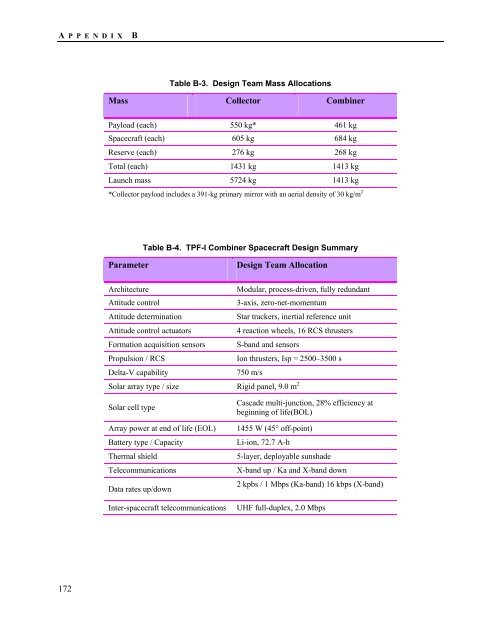TPF-I SWG Report - Exoplanet Exploration Program - NASA
TPF-I SWG Report - Exoplanet Exploration Program - NASA
TPF-I SWG Report - Exoplanet Exploration Program - NASA
Create successful ePaper yourself
Turn your PDF publications into a flip-book with our unique Google optimized e-Paper software.
A PPENDIX B<br />
Table B-3. Design Team Mass Allocations<br />
Mass Collector Combiner<br />
Payload (each) 550 kg* 461 kg<br />
Spacecraft (each) 605 kg 684 kg<br />
Reserve (each) 276 kg 268 kg<br />
Total (each) 1431 kg 1413 kg<br />
Launch mass 5724 kg 1413 kg<br />
*Collector payload includes a 391-kg primary mirror with an aerial density of 30 kg/m 2<br />
Table B-4. <strong>TPF</strong>-I Combiner Spacecraft Design Summary<br />
Parameter<br />
Design Team Allocation<br />
Architecture<br />
Modular, process-driven, fully redundant<br />
Attitude control<br />
3-axis, zero-net-momentum<br />
Attitude determination<br />
Star trackers, inertial reference unit<br />
Attitude control actuators<br />
4 reaction wheels, 16 RCS thrusters<br />
Formation acquisition sensors S-band and sensors<br />
Propulsion / RCS<br />
Ion thrusters, Isp = 2500–3500 s<br />
Delta-V capability<br />
750 m/s<br />
Solar array type / size Rigid panel, 9.0 m 2<br />
Solar cell type<br />
Array power at end of life (EOL)<br />
Battery type / Capacity<br />
Thermal shield<br />
Telecommunications<br />
Data rates up/down<br />
Inter-spacecraft telecommunications<br />
Cascade multi-junction, 28% efficiency at<br />
beginning of life(BOL)<br />
1455 W (45° off-point)<br />
Li-ion, 72.7 A-h<br />
5-layer, deployable sunshade<br />
X-band up / Ka and X-band down<br />
2 kpbs / 1 Mbps (Ka-band) 16 kbps (X-band)<br />
UHF full-duplex, 2.0 Mbps<br />
172
















